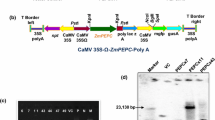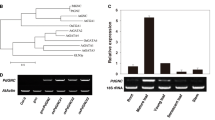Abstract
A gene encoding aminolevulinate synthase (ALA-S) in yeast (Saccharomyces cerevisiae YHem1) was introduced into the genome of tobacco (Nicoliana tabacum) under the control of Arabidopsis thaliana HemA1 gene promoter (AtHemA1 P). All transgenic lines transcribed the YHem1 gene, especially under light condition. The capacity to synthesize ALA and therefore chlorophyll was increased in transformed plants. Determination of gas exchange suggested that transgenic plants had significantly higher level of net photosynthetic rate (P n ), stomatal conductance (G s ) and transpiration rate (T r ), compared to the wild type (WT). Analysis with a modulated chlorophyll fluorometer demonstrated that the genetic transformation also caused a significant increase in photochemical efficiency of PSII (\( F^{\prime}_{v} /F^{\prime}_{m} \)), actual photochemical efficiency (Ф PSII ), photochemical quenching (qP), electron transfer rate (ETR) and the energy proportion in photochemistry (Pc), but decrease in proportion in heat dissipation (Hd). Chlorophyll-a fast fluorescence measurement and JIP-test indicated that photosynthetic performance index on cross section basis (PI CS ) and electron transport flux (ET o /CS) of transgenic tobacco were increased remarkably. And the probability that a trapped exciton can move a electron into the electron transport chain beyond Q − A (Ψ o ) and the density of active reaction centers (RC/CS) were also increased obviously in transgenic tobacco. These results imply that transgenic tobacco plants expressing YHem1 gene had higher photosynthetic capacity and energy conversion efficiency than the WT plants.






Similar content being viewed by others
References
Beale SI (2006) Biosynthesis of 5-aminolevulinic acid. In: Grimm B, Porra RJ, Rüdiger W, Scheer H (eds) Chlorophylls and bacteriochlorophylls: biochemistry, biophysics, functions and applications. Springer, Netherlands, pp 147–158
Bindu RC, Vivekanandan M (1998) Hormonal activities of 5-aminolevulinic acid in callus induction and micropropagation. Plant Growth Regul 26:15–18
Rebeiz CA, Juvik JA, Rebeiz CC (1988) Porphyric insecticides 1. Concept and phenomenology. Pestic Biochem Phys 30:11–27
Rebeiz CA, Montazerzouhoor A, Hopen HJ, Wu SM (1984) Photodynamic herbicides 1. Concept and phenomenology. Enzyme Microb Technol 6:390–401
Hotta Y, Tanaka T, Takaoka H, Takeuchi Y, Konnai M (1997) New physiological effects of 5-aminolevulinic acid in plants: the increase of photosynthesis, chlorophyll content, and plant growth. Biosci Biotech Bioch 61:2025–2028
Watanabe K, Tanaka T, Hotta Y, Kuramochi H, Takeuchi Y (2000) Improving salt tolerance of cotton seedlings with 5-aminolevulinic acid. Plant Growth Regul 32:99–103
Nishihara E, Kondo K, Parvez MM, Takahashi K, Watanabe K, Tanaka K (2003) Role of 5-aminolevulinic acid (ALA) on active oxygen-scavenging system in NaCl-treated spinach (Spinacia oleracea). J Plant Physiol 160:1085–1091
Watanabe K, Ryoji O, Rasid MM, Suliman A, Tohru T, Hitoshi K, Yasutomo T (2004) Effects of 5-aminolevulinic acid to recover salt damage on cotton, tomato, and wheat seedlings in Saudi-Arabia. J Arid Land Studies 14:105–113
Wang LJ, Jiang WB, Liu H, Liu WQ, Kang L, Hou XL (2005) Promotion by 5-aminolevulinic acid of germination of pakchoi (Brassica campestris ssp chinensis var. communis Tsen et Lee) seeds under salt stress. J Integr Plant Biol 47:1084–1091
Wang LJ, Jiang WB, Huang BJ (2004) Promotion of 5-aminolevulinic acid on photosynthesis of melon (Cucumis melo) seedlings under low light and chilling stress conditions. Physiol Plant 121:258–264
Wang LJ, Sun YP, Kang L, Zhang ZP (2010) Effects of 5-aminolevulinic acid (ALA) on photosynthesis and chlorophyll fluorescence of watermelon seedlings grown under low light and low temperature conditions. Acta Hort 856:159–166
Sun YP, Zhang ZP, Wang LJ (2009) Promotion of 5-aminolevulinic acid treatment on leaf photosynthesis is related with increase of antioxidant enzyme activity in watermelon seedlings grown under shade condition. Photosynthetica 47:347–354
Iida K, Mimura I, Kajiwara M (2002) Evaluation of two biosynthetic pathways to delta-aminolevulinic acid in Euglena gracilis. Eur J Biochem 269:291–297
von Wettstein D, Gough S, Kannangara CG (1995) Chlorophyll biosynthesis. Plant Cell 7:1039–1057
van der Werf MJ, Zeikus JG (1996) 5-Aminolevulinate production by Escherichia coli containing the Rhodobacter sphaeroides hemA gene. Appl Environ Microbiol 62:3560–3566
Wang JQ, Wu JH, Zhang ZM (2006) Expression of 5-aminolevulinic acid synthase in recombinant Escherichia coli. World J Microbiol Biotechnol 22:461–468
Zavgorodnyaya A, Papenbrock J, Grimm B (1997) Yeast 5-aminolevulinate synthase provides additional chlorophyll precursor in transgenic tobacco. Plant J 12:169–178
Jung S, Yang K, Lee DE, Back K (2004) Expression of Bradyrhizobium japonicum 5-aminolevulinic acid synthase induces severe photodynamic damage in transgenic rice. Plant Sci 167:789–795
Jung S, Back K, Yang K, Kuk YI, Chon SU (2008) Defence response produced during photodynamic damage in transgenic rice overexpressing 5-aminolevulinic acid synthase. Photosynthetica 46:3–9
McCormac AC, Fischer A, Kumar AM, Soll D, Terry MJ (2001) Regulation of HEMA1 expression by phytochrome and a plastid signal during de-etiolation in Arabidopsis thaliana. Plant J 25:549–561
Zhang ZP, Yao QH, Wang LJ (2010) Expression of yeast Hem1 gene controlled by Arabidopsis HemA1 promoter improves salt tolerance in Arabidopsis plants. BMB Rep 43:330–336
Jefferson RA, Kavanagh TA, Bevan MW (1987) Gus fusions-beta-glucuronidase as a sensitive and versatile gene fusion marker in higher-plants. EMBO J 6:3901–3907
Sambrook J, Russell DW (2001) Molecular cloning: a laboratory manual, 3rd edn. Cold Spring Harbor Laboratory Press, NY, pp 636–648
Bradford MM (1976) A rapid and sensitive method for the quantitation of microgram quantities of protein utilizing the principle of protein-dye binding. Ann Biochem 72:248–254
Harel E, Klein S (1972) Light dependent formation of δ-aminolevulinic acid in etiolated leaves of higher plants. Biochem Biophy Res Comm 49:364–370
Mauzerall D, Cranick S (1956) The occurrence and determination of δ-aminolevulinic acid and porphobilinogen in urine. J Biol Chem 219:435–446
Lichtenthaler HK (1987) Chlorophylls and carotenoids: pigments of photosynthetic biomembranes. Methods Enzymol 148:350–382
Lombardo ME, Araujo LS, Batlle A (2003) 5-Aminolevulinic acid synthesis in epimastigotes of Trypanosoma cruzi. Int J Biochem Cell B 35:1263–1271
Adams BD, Adams WW, Barker DH, Logan BA, Bowling DR, Verhoeven AS (1996) Using chlorophyll fluorescence to assess the fraction of absorbed light allocated to thermal dissipation of excess excitation. Physiol Plant 98:253–264
Strasser RJ, Govindjee (1992) The Fo and the O–J–I–P fluorescence rise in higher plants and algae. In: Argyroudi-Akoyunoglou JH (ed) Regulation of chloroplast biogenesis. Plenum Press, NY, pp 423–426
Strasser RJ, Tsimilli-Michael M, Srivastava A (2004) Analysis of chlorophyll a fluorescence transient. In: Papageorgiou GC, Govindjee (eds) Chlorophyll a fluorescence: a signature of photosynthesis. Springer, Netherlands, pp 321–362
Memon SA, Hou XL, Wang LJ, Li Y (2009) Promotive effect of 5-aminolevulinic acid on chlorophyll, antioxidative enzymes and photosynthesis of Pakchoi (Brassica campestris ssp. chinensis var. communis Tsen et Lee). Acta Physiol Plant 31:51–57
Youssef T, Awad MA (2008) Mechanisms of enhancing photosynthetic gas exchange in date palm seedlings (Phoenix dactylifera L.) under salinity stress by a 5-aminolevulinic acid-based fertilizer. J Plant Growth Regul 27:1–9
Tanaka Y, Tanaka A, Tsuji H (1993) Effects of 5-aminolevulinic acid on the accumulation of chlorophyll-b and apoproteins of the light-harvesting chlorophyll a/b-protein complex of photosystem-II. Plant Cell Physiol 34:465–472
Acknowledgments
This study was financially supported by the National Science Foundation of China (30471181).
Author information
Authors and Affiliations
Corresponding author
Rights and permissions
About this article
Cite this article
Zhang, ZP., Yao, QH. & Wang, LJ. Expression of yeast Hem1 controlled by Arabidopsis HemA1 promoter enhances leaf photosynthesis in transgenic tobacco. Mol Biol Rep 38, 4369–4379 (2011). https://doi.org/10.1007/s11033-010-0564-6
Received:
Accepted:
Published:
Issue Date:
DOI: https://doi.org/10.1007/s11033-010-0564-6




